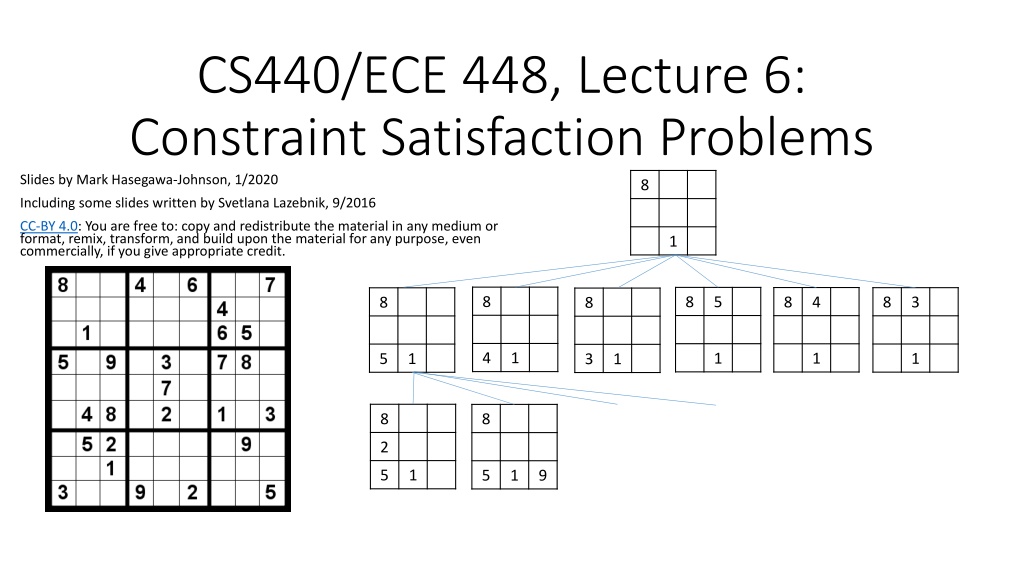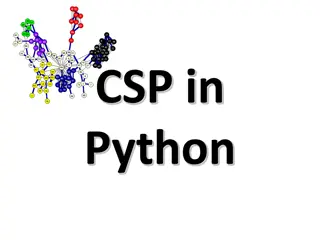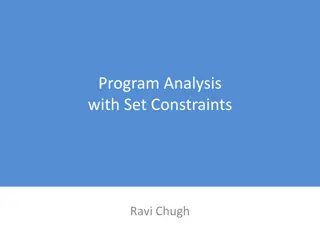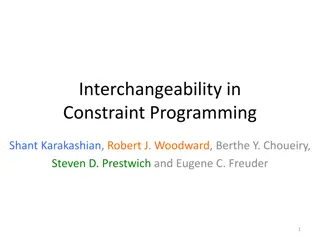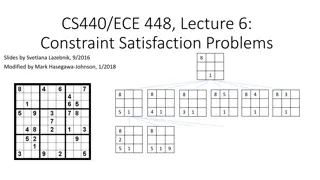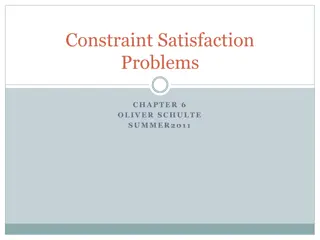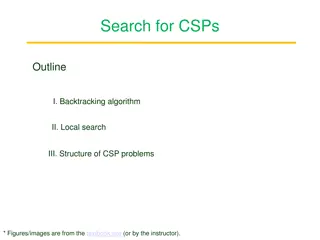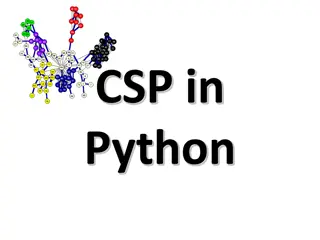Understanding Constraint Satisfaction Problems and Search
Constraint Satisfaction Problems (CSPs) involve assigning values to variables while adhering to constraints. CSPs are a special case of generic search problems where the state is defined by variables with possible values, and the goal is a consistent assignment. Map coloring is a classic example illustrating CSPs. CSPs differ from generic search problems due to the fixed path length, branching factor, and the computational cost of algorithms like DFS and BFS.
Download Presentation

Please find below an Image/Link to download the presentation.
The content on the website is provided AS IS for your information and personal use only. It may not be sold, licensed, or shared on other websites without obtaining consent from the author. Download presentation by click this link. If you encounter any issues during the download, it is possible that the publisher has removed the file from their server.
E N D
Presentation Transcript
CS440/ECE 448, Lecture 6: Constraint Satisfaction Problems Slides by Mark Hasegawa-Johnson, 1/2020 8 Including some slides written by Svetlana Lazebnik, 9/2016 CC-BY 4.0: You are free to: copy and redistribute the material in any medium or format, remix, transform, and build upon the material for any purpose, even commercially, if you give appropriate credit. 1 8 8 5 8 4 8 3 8 8 4 1 1 1 1 5 1 3 1 8 8 2 5 1 5 1 9
Content What is a CSP? Why is it search? Why is it special? Backtracking Search ?{1} heuristics to improve backtracking search ?{?} and ?{?2} heuristics: early detection of failure
What is search for? Assumptions: single agent, deterministic, fully observable, discrete environment Search for planning The path to the goal is the important thing Paths have various costs, depths Search for assignment Assign values to variables while respecting certain constraints The goal (complete, consistent assignment) is the important thing
Why are Constraint satisfaction problems (CSPs) just a special case of generic search problems? State is defined by N variables, each takes one of D possible values Goal test is a set of constraints specifying allowable combinations of values for subsets of variables. Solution is a complete, consistent assignment
Example: Map Coloring Variables: WA, NT, Q, NSW, V, SA, T Domains: {red, green, blue} Constraints: adjacent regions must have different colors Logical representation: WA NT Set representation: (WA, NT) in {(red, green), (red, blue), (green, red), (green, blue), (blue, red), (blue, green)}
Example: Map Coloring Solutions are complete and consistent assignments, e.g., WA = red, NT = green, Q = red, NSW = green, V = red, SA = blue, T = green
Why are Constraint satisfaction problems (CSPs) different from different from generic search problems? Because every path has N steps! So the computational cost of DFS, is the SAME as the cost of BFS, ? ??= ?{??} = ?{??} Path length is N, because there are N variables to assign Branching factor is D, because there are D possible values. Meanwhile, space is still a problem. DFS allows us to delete the part of the tree corresponding to an unsuccessful path. So DFS is more useful than BFS. Topic of today: how do we use heuristics with DFS? Hint: it s not as elegant as A*. There is no provable optimality. In fact
Computational complexity of CSPs The satisfiability (SAT) problem: Given a Boolean formula, is there an assignment of the variables that makes it evaluate to true? SAT and CSP are NP-complete NP: a class of decision problems for which the yes answer can be verified in polynomial time no known algorithm can find a yes answer, from scratch, in polynomial time An NP-complete problem is in NP and every other problem in NP can be efficiently reduced to it (Cook, 1971) Other NP-complete problems: graph coloring, n-puzzle, generalized sudoku It is not known whether P = NP, i.e., no efficient algorithms for solving SAT in general are known
Content What is a CSP? Why is it search? Why is it special? Backtracking Search ?{1} heuristics to improve backtracking search ?{?} and ?{?2} heuristics: early detection of failure
Backtracking search In CSP s, variable assignments are commutative For example, [WA = red then NT = green] is the same as [NT = green then WA = red] We only need to consider assignments to a single variable at each level (i.e., we fix the order of assignments) There are N! different orderings of the variables. If we choose a particular ordering, and then never change it, we reduce computational complexity by a factor of N! With a fixed order, there are still DNpossible paths. At each level, choose one of the D possible assignments, and explore to see if it gives you a solution. If not, backtrack: delete the whole sub-tree, and try something different. Depth-first search for CSPs with single-variable assignments is called backtracking search
Backtracking search algorithm Making backtracking search efficient: Which variable should be assigned next? In what order should its values be tried? Can we detect inevitable failure early?
Content What is a CSP? Why is it search? Why is it special? Backtracking Search ?{1} heuristics to improve backtracking search ?{?} and ?{?2} heuristics: early detection of failure
Content What is a CSP? Why is it search? Why is it special? Backtracking Search ?{1} heuristics to improve backtracking search 1. Given a particular variable, which value should you assign? 2. Which variable should you consider next? ?{?} and ?{?2} heuristics: early detection of failure
Given a variable, in which order should its values be tried? Making backtracking search efficient: Which variable should be assigned next? In what order should its values be tried? Can we detect inevitable failure early?
Given a variable, in which order should its values be tried? Least Constraining Value (LCV) Heurstic: Try the following assignment first: to the variable you re studying, the value that rules out the fewest values in the remaining variables Key intuition: maximize the probability of success.
Given a variable, in which order should its values be tried? Least Constraining Value (LCV) Heurstic: Try the following assignment first: to the variable you re studying, the value that rules out the fewest values in the remaining variables Which assignment for Q should we choose?
Which variable should be assigned next? Making backtracking search efficient: Which variable should be assigned next? In what order should its values be tried? Can we detect inevitable failure early?
Which variable should be assigned next? Key intuitions: If there is a solution possible, it will still be possible, regardless of the order in which you study the variables. So choosing a VARIABLE is easier than choosing a VALUE. Just minimize the branching factor. Least Remaining Values (LRV) Heuristic: Choose the variable with the fewest legal values Most Constraining Variable (MCV) Heuristic: Choose the variable that imposes the most constraints on the remaining variables
Which variable should be assigned next? Least Remaining Values (LRV) Heuristic: Choose the variable with the fewest legal values ??
Which variable should be assigned next? Most Constraining Variable (MCV) Heuristic: Choose the variable that imposes the most constraints on the remaining variables Tie-breaker among variables that have equal numbers of LRV
Which variable should be assigned next? Most Constraining Variable (MCV) Heuristic: Choose the variable that imposes the most constraints on the remaining variables Tie-breaker among variables that have equal numbers of MRV ??
Content What is a CSP? Why is it search? Why is it special? Backtracking Search ?{1} heuristics to improve backtracking search ?{?} and ?{?2} heuristics: early detection of failure
Early detection of failure: O{N} checking Forward Checking: Check to make sure that every variable still has at least one possible assignment
Early detection of failure: O{N} checking Forward checking Keep track of remaining legal values for unassigned variables Terminate search when any variable has no legal values WA T NT NSW Q SA V
Early detection of failure: O{N} checking Forward checking Keep track of remaining legal values for unassigned variables Terminate search when any variable has no legal values WA T NT NSW Q SA V
Early detection of failure: O{N} checking Forward checking Keep track of remaining legal values for unassigned variables Terminate search when any variable has no legal values WA T NT NSW Q SA V
Early detection of failure: O{N} checking Forward checking Keep track of remaining legal values for unassigned variables Terminate search when any variable has no legal values WA T NT NSW Q SA V
Early detection of failure: O{N^2} checking Arc consistency: Check to make sure that every PAIR of variables (every arc ) still has a pair- wise assignment that satisfies all constraints
Does arc consistency always detect the lack of a solution? B A D B A D C C There exist stronger notions of consistency (path consistency, k-consistency), but we won t worry about them
Summary CSPs are a special kind of search problem: States defined by values of a fixed set of variables Goal test defined by constraints on variable values Backtracking = depth-first search where successor states are generated by considering assignments to a single variable Variable ordering (LRV, MCV) and value selection (LCV) heuristics can help significantly Forward checking says: don t consider an assignment if it leaves any variable with no remaining possible values Arc consistency says: don t consider an assignment if it leaves any pair of variables with no remaining mutually compatible pair of values Complexity of CSPs NP-complete in general (exponential worst-case running time) Typical run-time can be reduced substantially using polynomial- complexity forward-checking and arc-consistency heuristics
